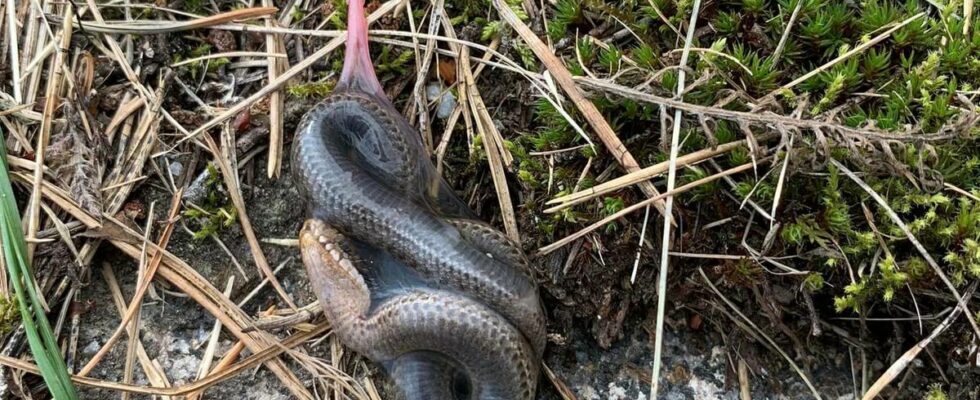The case in summary: Solveig Martinsen in Rakkestad caught a rare viper birth on film. Vipers are ovoviviparous animals, meaning they give birth to live young, not eggs. The number of young can vary from 1 to 20, and around half grow up. The viper is Norway’s only poisonous snake, and every year more people are bitten. So far this year, Poison Information has received over 580 inquiries about viper bites. The summary is made by an AI service from OpenAi. The content is quality assured by news’s journalists before publication. – Suddenly something came out of its butt. Solveig Martinsen was quickly on the phone when a rather thick snake appeared outside her house. – It was my husband who discovered it when it crawled across the road. He thought it was unnaturally thick. And suddenly something appears from the rear end of the viper. Solveig Martinsen is a keen nature lover, and likes to take pictures of things she finds. Photo: Privat A thin, small bag that suddenly burst, explains Martinsen, who managed to capture some of the incident on film. – We saw the slime bag come out, the kid also crawled away. During the summer months, Martinsen can see vipers almost every day in the immediate area of Rakkestad. But even though she has been stationed there for close to 40 years, she has never witnessed a viper birth. – We have quite a few vipers on our property, but I had never seen this before! It is a rare sight to see a viper birth. Here, mother viper has just finished. Zoologist: – Isn’t everyone lucky Not even Dag Dolmen is used to seeing viper births in reality. He is a retired zoologist at NTNU and a specialist in reptiles and amphibians. – Being able to witness a viper birth is not for everyone. I have not even once, and I have followed the viper for many years, says Dolmen. Usually the viper tends to give birth in thickets in a place where they are difficult to find. And for anyone who thought that the viper laid eggs, the answer to that is both yes and no. Dag Dolmen is associated with the NTNU Science Museum in Trondheim, and is among the country’s foremost experts on reptiles and amphibians. Photo: Private – The viper is a so-called ovoviviparous animal. That is, it gives birth to eggs or lays young. You can use the expression you want, says Dolmen. There is therefore not an eggshell there, as many are used to from hens’ eggs. Instead, only a thin membrane surrounds the viper babies. – Then the membrane bursts when the birth takes place. Within a few seconds, a small viper crawls out. The number of young can vary from 1 to 20, and around half grow up. It is often the case that the viper gives birth every two years. Maternity leave lasts for one day, after which mother and child rarely have anything to do with each other again. More inquiries The viper is Norway’s only venomous snake, and every year more people are bitten. So far this year, Poison Information has received over 580 inquiries about viper bites. On average, they receive approx. 577 inquiries this year. 2024 is thus above average, despite the fact that the year is far from over. – We probably have the impression that the weather has a lot to say about the number of inquiries we receive about viper bites. But it is natural, since on sunny days we are more often outside where the worm travels. And preferably barefoot or in light shoes. That’s what the department head at Poison Information, Mari Tosterud, tells news. The situation in Rakkestad was also biting. Was carried away After the kid had gotten out of his bag, Solveig Martinsen’s husband took out a bucket. Not everyone wants vipers in their garden. – The man took both the mother and the child into the bucket. And when the little cub came up in the bucket, it bit the mother. I have no idea why. Fortunately for the mother, the baby snake has the same type of poison. It hardly took any damage from the bite. Here is the baby viper just after birth. Photo: Private – So you weren’t scared? – No, then! As long as you don’t touch the viper, you’ll be fine. We have seen quite a few here this year. But I’ve never been bitten. Published 06.09.2024, at 1:30 p.m
ttn-69
Unique video – news Østfold – Local news, TV and radio

